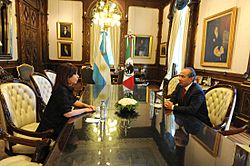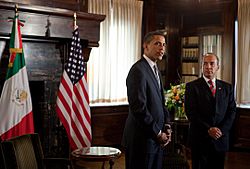Felipe Calderón facts for kids
Quick facts for kids
Felipe Calderón
|
|
|---|---|
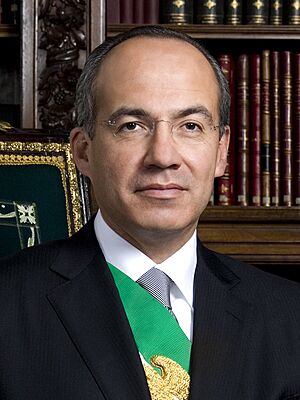
Official portrait, 2006
|
|
| 63rd President of Mexico | |
| In office 1 December 2006 – 30 November 2012 |
|
| Preceded by | Vicente Fox |
| Succeeded by | Enrique Peña Nieto |
| Secretary of Energy of Mexico | |
| In office 2 September 2003 – 1 June 2004 |
|
| President | Vicente Fox |
| Preceded by | Ernesto Martens |
| Succeeded by | Fernando Elizondo Barragán |
| Director General of the National Works and Public Services Bank | |
| In office 12 February 2003 – 2 September 2003 |
|
| President | Vicente Fox |
| Preceded by | Tomás Ruiz González |
| Succeeded by | Luis Pazos |
| President of the Political Coordination Board of the Chamber of Deputies | |
| In office 1 September 2001 – 31 August 2002 |
|
| Preceded by | Beatriz Paredes Rangel |
| Succeeded by | Martí Batres Guadarrama |
| Member of the Chamber of Deputies for Michoacán (5th electoral region) |
|
| In office 1 September 2000 – 12 February 2003 |
|
| Succeeded by | Nohelia Linares González |
| In office 1 September 1991 – 31 August 1994 |
|
| President of the National Action Party | |
| In office 9 March 1996 – 9 March 1999 |
|
| Preceded by | Carlos Castillo Peraza |
| Succeeded by | Luis Felipe Bravo Mena |
| Personal details | |
| Born |
Felipe de Jesús Calderón Hinojosa
18 August 1962 Morelia, Michoacán, Mexico |
| Political party | National Action Party (before 2018) |
| Other political affiliations |
México Libre |
| Spouse | |
| Children | 3 |
| Parents | Luis Calderón Vega María del Carmen Hinojosa |
| Relatives | Calderón Hinojosa family |
| Alma mater | Free School of Law (LLB) Mexico Autonomous Institute of Technology (MA) Harvard University (MPA) |
| Cabinet | Cabinet of Felipe Calderón |
| Awards | |
| Signature |  |
Felipe de Jesús Calderón Hinojosa (born August 18, 1962) is a Mexican politician and lawyer. He served as the 63rd president of Mexico from 2006 to 2012. Before becoming president, he was the Secretary of Energy under President Vicente Fox. For 30 years, he was a member of the National Action Party (PAN).
In the 2006 presidential election, Calderón won by a very small margin. The results were very close, with Calderón winning by only 0.6% of the total votes. His opponent, Andrés Manuel López Obrador, questioned the results. However, Calderón's victory was confirmed by Mexico's Federal Electoral Tribunal.
A major focus of his presidency was the fight against organized crime. Just ten days after taking office, he began a strong campaign to make the country safer. This effort involved using the military to confront powerful criminal groups.
During his time as president, Calderón also focused on other important issues. He helped create ProMéxico in 2007 to support Mexican businesses around the world. His government also worked to give all Mexicans access to healthcare through a program called Seguro Popular. By 2012, this goal of universal healthcare was achieved.
Contents
Personal Life
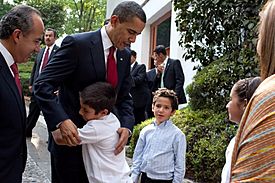
Early Life and Family
Felipe Calderón was born in Morelia, Michoacán, Mexico. He is the youngest of five brothers. His father, Luis Calderón Vega, was one of the founders of the National Action Party (PAN).
Growing up, Felipe was very involved in his father's political work. He helped by handing out flyers and joining in campaign events. This early experience sparked his interest in politics.
After finishing his early education in Morelia, Calderón moved to Mexico City. He earned a degree in law from the Escuela Libre de Derecho. He later received a master's degree in economics and another master's degree in Public Administration from Harvard University.
He met his wife, Margarita Zavala, through their work in the PAN party. She also served in the Mexican Congress. They have three children: María, Luis Felipe, and Juan Pablo.
Political Career

Felipe Calderón began his political career at a young age. In his early twenties, he was the president of the PAN's youth organization.
He served as a representative in both his local state government and the federal Chamber of Deputies. From 1996 to 1999, he was the national president of the PAN party.
When Vicente Fox became president in 2000, he appointed Calderón as the director of Banobras, a government-owned bank. Later, Calderón became the Secretary of Energy. He left this position in 2004 to focus on his goal of becoming president.
2006 Presidential Campaign
Calderón competed against other members of his party to become the PAN's presidential candidate. He won the primary elections, which surprised many people. His victory showed that the PAN party had a democratic way of choosing its candidates.
His campaign grew stronger after the first presidential debate. For a while, polls showed he was ahead of his main rival, Andrés Manuel López Obrador. The election on July 2, 2006, was extremely close. The final results showed that Calderón had won, but by a very narrow margin.
Presidency (2006-2012)
| Presidential styles of Felipe Calderón |
|
|---|---|
| Reference style | Presidente de los Estados Unidos Mexicanos "President of the United Mexican States" |
| Spoken style | Presidente de Mexico "President of Mexico" |
| Alternative style | Señor Presidente "Mr. President" |
Calderón's inauguration on December 1, 2006, was a tense event. Members of the opposing party protested during the ceremony. Because he won by such a small number of votes, his presidency faced challenges from the very beginning.
To build support, he quickly took action on important issues. One of his first major decisions was to launch a strong security campaign against organized crime groups.
Domestic Policy
President Calderón focused on several key areas to improve life in Mexico. He worked to create jobs, improve education, and expand healthcare.
Health and Education
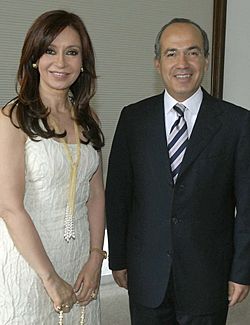
One of the most popular policies of his administration was expanding healthcare. Through a program called Seguro Popular, his government worked to give every Mexican access to health services. By the end of his term, over 100 million Mexicans had health coverage.
His government also built or improved thousands of hospitals and clinics. In education, he created 96 new universities, the most in Mexico's history. He also made sure every child had a place in elementary school.
In 2009, the swine flu epidemic hit Mexico. Calderón's government acted quickly to inform the public and control the spread of the virus. They closed schools and other public places to keep people safe.
Economic Policy
Calderón's government worked to strengthen Mexico's economy. He focused on attracting investment from other countries. Many car companies built new factories in Mexico during his presidency. This made Mexico one of the world's top auto manufacturers.
He also worked to keep prices stable. When the price of corn went up, his government made an agreement with major companies to keep the price of tortillas low. This was called the Tortilla Price Stabilization Pact. It helped protect families from rising food costs.
Infrastructure
The Calderón administration invested heavily in infrastructure. This means they built and improved roads, bridges, and other public works. Over 16,500 kilometers of highways were built.
One major project was the Baluarte Bridge, which opened in 2012. It is one of the highest cable-stayed bridges in the world. The bridge made travel much faster between the cities of Mazatlán and Durango.
Security Policy

On his first day in office, President Calderón raised the salaries of the Federal Police and the Mexican Armed Forces. He believed this would help in the fight for a safer Mexico.
Shortly after, he launched a major security operation. He sent military forces to different parts of the country to confront powerful crime groups. This effort is often called the Mexican Drug War.
The government successfully captured many high-level crime leaders. During his term, 25 of the 37 most-wanted criminals were captured or defeated. However, the fight was very difficult and led to a period of increased violence in certain areas, especially near the U.S. border.
Foreign Policy

President Calderón worked to strengthen Mexico's relationships with other countries. He was a strong supporter of free trade and cooperation.
He promoted the Mesoamerica Project, which aimed to improve infrastructure and development in Mexico and Central America. He also worked closely with the United States on the Mérida Initiative. This was a partnership to improve security and combat crime in the region.
In 2010, Mexico hosted a major United Nations conference on climate change in Cancún. The successful outcome of the conference, known as the Cancún Accord, earned praise from around the world.
Honors and Awards
Throughout his career, Felipe Calderón has received many honors from other countries. These awards recognize his leadership and contributions to international relations.
 Belize: Order of Belize
Belize: Order of Belize Brazil: Grand Collar of the Order of the Southern Cross
Brazil: Grand Collar of the Order of the Southern Cross Denmark: Knight of the Order of the Elephant
Denmark: Knight of the Order of the Elephant Spain: Knight of the Collar of the Order of Isabella the Catholic
Spain: Knight of the Collar of the Order of Isabella the Catholic United Kingdom: Honorary Knight Grand Cross of the Order of the Bath
United Kingdom: Honorary Knight Grand Cross of the Order of the Bath
See also
 In Spanish: Felipe Calderón para niños
In Spanish: Felipe Calderón para niños
- List of heads of state of Mexico
- History of Mexico
- Politics of Mexico



